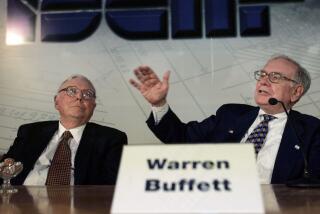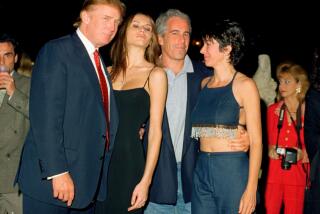The Wizard of Wall Street
- Share via
As Jean Strouse’s fascinating book makes clear, there was more than one Pierpont Morgan. At the center was the Man himself, a presence that awed all who came into contact with him, not least because of the Nose--a monstrous empurpled bulb of rhinophymatic tissue that dominated his visage. Inherited from his grandfather, who had a milder case, the Nose, flanked by blazing eyes, transfixed every visitor. In later life, Morgan was once asked why he did not have the nose made somewhat less conspicuous by surgery. He replied that no one would recognize him without it. In fact, however, it was not the face alone that endowed the Man with his extraordinary power. It was the utterly unexpected moments, just when the target of his fury felt himself about to be reduced to dust, that a quiet voice was heard to say, without even the trace of an exclamation point: “I am mistaken. You are right.”
Thus it was not the blazing exterior that made Morgan so formidable. It was a reflective interior that the scowls and frowns concealed from view. Morgan the Banker was thus the embodiment of Morgan the Man. But what lay within that inscrutable being?
Of Morgan the child we know very little. He was the product of two very different families, the ecclesiastical Pierponts on his mother’s side and the financially oriented Morgans on his father’s. Both families were pre-American Revolution but otherwise could not have been less alike. Strouse describes the Pierponts as “competent, energetic . . . exacting and stern”; the Morgans as “reckless, impecunious, at odds with one another, plagued with physical and psychological troubles. They were undoubtedly a mess.”
The families got together when Junius Morgan, stunningly handsome and already making money in finance, married Juliet Pierpont, who had inherited from her father the skin ailment that would become her son’s hallmark. The baby was baptized John Pierpont Morgan but was known all his life by the last two names alone. From such contrasting family backgrounds emerged the person of the seemingly incompatible characteristics we have already noted. Strouse describes them thus:
“At times he seemed made of contradictions. Conservative by nature and reverential toward tradition, he had democratic instincts and an acute receptivity to new ways of doing things. Though physically robust . . . he worried constantly about his health. He was sociable and shy, deliberate and impulsive, ingenuous and shrewd, domineering and flexible, exuberant and depressive, extravagant and frugal, worldly and religious, inscrutably and deeply sentimental.”
Evidently the contradictions, no doubt muted in a young man, did not prevent Pierpont from finding a place for himself in the financial world of his father’s friends and associates: His employer wrote that he considered him a “very promising young man.” One more important thing: In his 20s he fell in love with Amelia Osborn, daughter of the president of the Illinois Central Railroad. Memie (pronounced Mimi) had been crowned beauty queen of a New York ball, played piano, spoke French and German and taught sewing to young women. Alas, she was also afflicted with a tubercular ailment that proved fatal less than a year after they married. It was a crushing blow for Pierpont, and this sad beginning had no happy ending. Within a few years he married again, this time begetting children, but the second marriage soon became distanced. For the rest of his life, Morgan sought and found female company, including a number of interesting and attractive women who turned to him with genuine affection, but although he was never alone, a growing loneliness marked his life.
Meanwhile, as Morgan’s stature in the world of financial affairs was rapidly growing, he found himself simultaneously drawn into a new passion--collecting art. Indeed, it is fair to say that Morgan gradually took it upon himself to transform a country virtually without respectable collections of Egyptian, Greek, Roman, medieval, Renaissance or even American painting and sculpture into a nation whose best museums would rival those of Europe. As to the degree of his success in quality as well as quantity, there is room for disagreement: One German scholar declared Morgan to be “the most important art collector I have ever met,” but a British critic declared that Morgan’s taste testified to a “well-nigh perfect insensibility.” Whatever today’s judgment, collecting art was indeed a grand pursuit for Morgan, second only to a mission coming ever more urgently to the fore--finding a basis for stabilizing an increasingly unstable American economic system.
The concern for stability was rooted in a hell-for-leather speculative boom gathering steam in the 1890s. In 1907, the boom exploded in a panic that shook the financial world to its roots, threatening to bankrupt big as well as small companies, to empty banks’ vaults as well as stockholders’ pockets, even raising the specter of a forced shutdown of the stock exchange itself. This disaster was prevented only when Morgan, acting unofficially but without opposition, emerged as the nation’s strategic banker, arranging for his own and other firms to supply as much liquidity as might be needed to forestall a general collapse.
Fortunately, it worked, and his name became ever more prominent--feared by those who foresaw a plutocratic takeover of national affairs, admired by others who felt blessed that the national economy was under the guidance of a banker whose moral as well as economic status was recognized by all.
Not surprisingly, Congress decided to look into the situation. In 1912, the Pujo Committee (named for Chairman Arsene Pujo) began a lengthy inquiry into the causes of the stock market panic, choosing as its primary interrogator Samuel Untermyer, an experienced corporate lawyer and sharp critic of the “Money Trust.” This was not, in itself, an attack on Morgan; as we have already noted, Morgan greatly feared the threat to the stability of the nation’s financial viability posed by an unstable stock market.
The question was what to do about it. In the days before the New Deal would bring a new legitimacy to public regulation of finance, the only possible answer was to resort to someone who could serve as the nation’s central banker by virtue of his skill, acumen, courage, temper and openness to new ideas. There was, of course, only one such person. Thus when we read the interplay between Untermyer and Morgan--testimony before the commission on the question of controlling money and credit--the questions seem sharp but not hostile; the responses bland to the point of innocence but not evasive. A small section from the voluminous original follows.
Untermyer: You are opposed to competition, are you not?
Morgan: No, I do not mind competition.
Untermyer: You are an advocate of combination and cooperation, as against competition, are you not?
Morgan: Yes. Cooperation I should favor.
Untermyer: Combination as against competition?
Morgan: I do not object to competition either. I like a little competition.
The questions and answers continue for pages until finally we come to what Strouse calls the most famous exchange of their colloquy. Untermyer asks whether credit is not ultimately based on money--that is, do not the big New York banks issue loans to certain men and institutions “because it is believed that they have the money back of them?”
Morgan: No sir. It is because people believe in the man.
Untermyer: And he might not be worth anything?
Morgan: He might not have anything. I have known a man to come into my office and I have given them [sic] a check for a million dollars when I knew they had not a cent in the world.
Untermyer: That is not business?
Morgan: Yes, unfortunately it is. I do not think it is good business, though.
Untermyer repeats his proposition: Is not commercial credit based primarily upon money and property?
Morgan: No sir; the first thing is character.
Untermyer: Before money or property?
Morgan: Before money or property or anything else. Money cannot buy it because a man I do not trust could not get money from me on all the bonds in Christendom.
We smile, but the country felt a great relief. Morgan emerged from the hearings a hero. He left shortly for Egypt; then, feeling poorly, went on to Rome, where he became seriously ill. He died on March 31, 1913, not quite 76. Four thousand condolences poured in to the Grand Hotel, where he lay; the Italian army marched in his honor, as did the French. In New York City, flags were lowered to half staff, save for those on Wall Street, which had anticipated the event by a day and therefore did not have to be lowered. But as one journalist wrote, there was no doubt that a historic moment had been reached. He went on to write: “There are no cries of ‘long live the king!’, for the general verdict seems to be that there will be no other king. We are facing other days.”
The funeral was held in the family hometown of Hartford, Conn. Elaborate floral tributes from governments the world over embellished the chancel, but the service was simple and mirrored as closely as possible that of Junius Morgan, his father. The main news the next day concerned the will. It provided in detail for the financial well-being of all of Pierpont’s friends and family. Central, of course, was the often-asked question of how rich he was. His financial assets came to less than $100 million; his art collection roughly half that, both worth perhaps 20 times that in today’s values. Thus he was not the richest man in the world, only the most economically powerful.
No one else has told the story of Pierpont Morgan in the detail, depth and understanding of Jean Strouse, who spent nearly a decade searching for the living truth behind the mythology of Morganalia. This effort, recounted to marvelous effect in the March 29 issue of The New Yorker, took Strouse to many previously unexplored sources of the Morgan saga, some in neglected documents, others in the memories of still-living acquaintances. It is a riveting detective story, oddly left out of the book. It is a pity, for “Morgan” is in every other respect a masterpiece.
More to Read
Sign up for our Book Club newsletter
Get the latest news, events and more from the Los Angeles Times Book Club, and help us get L.A. reading and talking.
You may occasionally receive promotional content from the Los Angeles Times.










